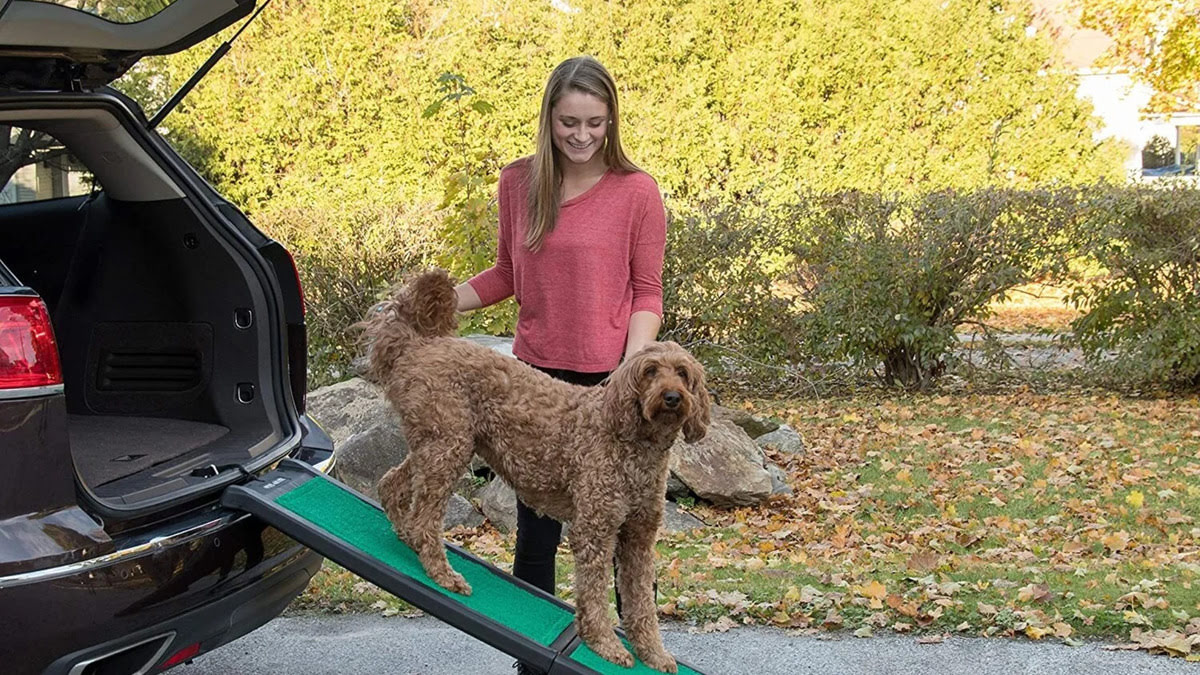Home>Health & Wellness>Common Health Issues>Muscular and Joint Health>Dog’s Back Leg Muscles Weak And Shaking Due To Arthritis: How To Remedy And Strengthen


Muscular and Joint Health
Dog’s Back Leg Muscles Weak And Shaking Due To Arthritis: How To Remedy And Strengthen
Modified: February 21, 2024
Learn how to remedy and strengthen your dog's weak and shaking back leg muscles caused by arthritis. Improve your dog's muscular and joint health with effective solutions.
(Many of the links in this article redirect to a specific reviewed product. Your purchase of these products through affiliate links helps to generate commission for Pawsomeoldies.com, at no extra cost. Learn more)
Table of Contents
Understanding Arthritis in Dogs
Arthritis is a common condition that affects dogs, particularly as they age. It is characterized by inflammation and stiffness in the joints, leading to discomfort and reduced mobility. Just like humans, dogs can experience arthritis in various parts of their bodies, including their back legs. This condition can cause weakness and shaking in the muscles, making it challenging for dogs to move around comfortably.
Arthritis in dogs can be attributed to a range of factors, including genetics, obesity, joint injuries, and the natural aging process. Large dog breeds are especially prone to developing arthritis due to the added strain on their joints. Additionally, certain medical conditions, such as hip dysplasia and ligament injuries, can contribute to the onset of arthritis in dogs.
The most common type of arthritis in dogs is osteoarthritis, which occurs when the protective cartilage within the joints begins to deteriorate, leading to friction and inflammation. This can result in pain and discomfort for the affected dog, particularly when engaging in physical activities.
It's important for dog owners to recognize the signs of arthritis in their pets, as early intervention can help manage the condition more effectively. Common symptoms of arthritis in dogs include limping, reluctance to engage in physical activities, stiffness, and difficulty rising from a lying position. Additionally, dogs with arthritis may exhibit changes in their behavior, such as increased irritability or decreased interest in play.
Understanding the underlying causes and symptoms of arthritis in dogs is crucial for providing appropriate care and support for our canine companions. By recognizing the signs of arthritis and its impact on a dog's back leg muscles, pet owners can take proactive measures to alleviate discomfort and improve their pet's quality of life.
Read more: How To Treat A Dog With Back Arthritis
Identifying Weak and Shaking Back Leg Muscles in Dogs
When it comes to identifying weak and shaking back leg muscles in dogs, attentive observation and understanding of your pet's behavior are essential. Dogs affected by arthritis often display noticeable signs of discomfort and reduced mobility, particularly in their hind limbs. As a responsible pet owner, being able to recognize these indicators can prompt timely intervention to alleviate your dog's discomfort and enhance their overall well-being.
One of the primary signs of weak and shaking back leg muscles in dogs with arthritis is a noticeable change in their gait. You may observe that your dog is favoring one leg over the other or exhibiting a reluctance to put weight on a specific limb. This can manifest as a limp or an uneven stride, indicating discomfort and weakness in the affected leg muscles. Additionally, dogs with arthritis may struggle to rise from a lying position, often displaying hesitancy or instability when attempting to stand up.
Furthermore, dogs experiencing weakness in their back leg muscles may exhibit trembling or shaking in the affected limbs, especially when standing or attempting to move. This trembling can be a result of muscle fatigue and strain due to the arthritic condition, causing discomfort and instability in the affected limbs. It's important to differentiate this trembling from normal muscle twitching, as persistent shaking in the back legs can signify an underlying issue that requires attention.
In addition to changes in gait and trembling, dogs with weak back leg muscles may display signs of discomfort when engaging in physical activities. This can include reluctance to climb stairs, jump onto furniture, or participate in regular exercise. You may notice your dog hesitating or exhibiting signs of pain when attempting these activities, indicating the strain on their back leg muscles caused by arthritis.
Observing your dog's behavior and movement patterns is crucial for identifying weak and shaking back leg muscles associated with arthritis. By paying close attention to these subtle yet telling signs, you can gain valuable insights into your pet's condition and take proactive measures to address their discomfort.
Recognizing these indicators and understanding their implications can empower pet owners to seek appropriate remedies and support for their furry companions, ultimately enhancing their quality of life and well-being.
Remedies for Strengthening Back Leg Muscles in Dogs with Arthritis
Addressing the weakness and shaking of back leg muscles in dogs with arthritis requires a multifaceted approach aimed at improving muscle strength, reducing discomfort, and enhancing overall mobility. By implementing targeted remedies, pet owners can effectively support their canine companions in managing the challenges posed by arthritis. Here are several key strategies for strengthening back leg muscles in dogs with arthritis:
Weight Management:
Maintaining an optimal body weight is crucial for dogs with arthritis, as excess weight places additional strain on their joints and muscles. By ensuring that your dog maintains a healthy weight, you can alleviate unnecessary pressure on their back leg muscles, promoting improved mobility and reducing discomfort associated with arthritis.
Low-Impact Exercise:
Engaging in low-impact exercise routines tailored to the specific needs of dogs with arthritis can help strengthen their back leg muscles while minimizing strain on their joints. Activities such as swimming, gentle walks, and controlled play sessions can promote muscle endurance and flexibility without exacerbating discomfort.
Read more: When To Put Your Dog Down Due To Arthritis
Physical Therapy:
Professional physical therapy tailored to dogs with arthritis can be highly beneficial in strengthening their back leg muscles. Therapeutic exercises and techniques, including targeted massage, passive range of motion exercises, and controlled movements, can help improve muscle tone and mobility, contributing to enhanced strength and stability in the affected limbs.
Joint Support Supplements:
Incorporating joint support supplements, such as glucosamine and chondroitin, into your dog's daily regimen can aid in maintaining joint health and reducing inflammation. These supplements can support the integrity of the cartilage within the joints, potentially alleviating discomfort and promoting improved muscle function in the back legs.
Assistive Devices:
Utilizing assistive devices, such as orthopedic braces or harnesses, can provide additional support for dogs with weak back leg muscles due to arthritis. These devices can help stabilize the affected limbs, reduce strain during movement, and promote better weight distribution, ultimately contributing to enhanced muscle strength and comfort.
Environmental Modifications:
Making adjustments to your dog's environment to minimize physical obstacles and provide supportive surfaces can aid in strengthening their back leg muscles. Providing comfortable bedding, ramps for easier access to elevated areas, and non-slip flooring can create a more accommodating environment for dogs with arthritis, facilitating improved mobility and muscle function.
By implementing these targeted remedies, pet owners can play a proactive role in strengthening the back leg muscles of dogs affected by arthritis, ultimately enhancing their overall comfort and quality of life. These strategies, when combined with regular veterinary care and ongoing monitoring, can contribute to a comprehensive approach to managing arthritis-related muscle weakness in dogs.
Exercise and Physical Therapy for Dogs with Weak Back Leg Muscles
Implementing targeted exercise and physical therapy regimens is paramount in addressing the challenges faced by dogs with weak back leg muscles due to arthritis. These proactive measures aim to enhance muscle strength, improve mobility, and alleviate discomfort, ultimately contributing to an improved quality of life for our canine companions.
Tailored Exercise Routines:
Designing tailored exercise routines that cater to the specific needs of dogs with weak back leg muscles is essential. Low-impact activities, such as swimming and gentle walks, can effectively strengthen the muscles without placing excessive strain on the joints. These exercises promote muscle endurance and flexibility, contributing to improved mobility and overall physical well-being. Additionally, controlled play sessions tailored to the individual capabilities of the dog can provide opportunities for muscle strengthening while minimizing discomfort.
Professional Physical Therapy:
Professional physical therapy tailored to dogs with weak back leg muscles can yield significant benefits. Therapeutic exercises, including passive range of motion movements and targeted massage, can help improve muscle tone and flexibility. Moreover, controlled movements under the guidance of a qualified therapist can aid in enhancing muscle strength and stability in the affected limbs. Physical therapy sessions are designed to address the specific needs of each dog, providing a personalized approach to strengthening weak back leg muscles and mitigating the impact of arthritis.
Rehabilitation Equipment:
Incorporating rehabilitation equipment, such as balance balls and obstacle courses, into the exercise and physical therapy regimen can further enhance muscle strength and coordination. These tools provide opportunities for targeted muscle engagement and balance improvement, contributing to the overall stability and functionality of the back leg muscles. Additionally, incorporating rehabilitation equipment into the routine can stimulate mental engagement and provide a positive outlet for physical activity, promoting holistic well-being for dogs with weak back leg muscles.
Consistency and Monitoring:
Consistency in implementing exercise and physical therapy routines is crucial for achieving positive outcomes. Regular, structured sessions tailored to the individual capabilities and limitations of the dog can yield gradual yet significant improvements in muscle strength and mobility. Furthermore, ongoing monitoring of the dog's progress and response to the therapy allows for adjustments to be made as needed, ensuring that the exercise and physical therapy regimen remains effective and supportive of the dog's well-being.
By incorporating tailored exercise routines, professional physical therapy, rehabilitation equipment, and consistent monitoring, pet owners can actively contribute to strengthening the weak back leg muscles of dogs affected by arthritis. These proactive measures, when integrated into a comprehensive care plan, can significantly enhance the comfort, mobility, and overall quality of life for our beloved canine companions.
Diet and Supplements for Dogs with Arthritis
A well-balanced diet and targeted supplementation play a pivotal role in managing arthritis in dogs, particularly in addressing the associated weakness and shaking of back leg muscles. By focusing on dietary considerations and incorporating specific supplements, pet owners can actively support their canine companions in alleviating discomfort and promoting improved muscle function.
Balanced Nutrition:
Ensuring that dogs with arthritis receive a balanced and nutritious diet is essential for their overall well-being. High-quality commercial dog foods or homemade meals prepared under the guidance of a veterinarian can provide the necessary nutrients to support joint health and muscle function. Incorporating lean proteins, healthy fats, and a variety of vitamins and minerals can contribute to the maintenance of muscle strength and overall vitality.
Omega-3 Fatty Acids:
Supplementation with omega-3 fatty acids, such as fish oil, can offer significant benefits for dogs with arthritis. These essential fatty acids possess anti-inflammatory properties, potentially reducing joint inflammation and alleviating discomfort. Moreover, omega-3 fatty acids can support overall joint health, contributing to improved mobility and reduced stiffness in the back leg muscles.
Glucosamine and Chondroitin:
Incorporating joint support supplements containing glucosamine and chondroitin can aid in maintaining the integrity of the cartilage within the joints. These supplements have been shown to support joint health and reduce the progression of arthritis-related changes. By promoting the health of the joints, glucosamine and chondroitin supplementation can contribute to improved muscle function and reduced discomfort in dogs with arthritis.
Antioxidants:
Antioxidants, such as vitamins C and E, can play a valuable role in managing arthritis in dogs. These compounds help combat oxidative stress and inflammation, potentially mitigating the impact of arthritis on the muscles and joints. By incorporating antioxidant-rich foods or supplements into the dog's diet, pet owners can support the overall well-being of their pets and contribute to enhanced muscle function.
Weight Management:
Maintaining an optimal body weight is closely linked to diet and can significantly impact the management of arthritis in dogs. Excess weight places additional strain on the joints and muscles, exacerbating discomfort and weakness. By ensuring that dogs with arthritis maintain a healthy weight through appropriate portion control and dietary management, pet owners can alleviate unnecessary pressure on the back leg muscles, promoting improved mobility and overall comfort.
By focusing on a balanced nutrition plan and incorporating targeted supplements, pet owners can actively contribute to the well-being of dogs with arthritis. These dietary considerations, when combined with other supportive measures, form a comprehensive approach to managing the challenges posed by arthritis-related weakness and shaking of back leg muscles in dogs.











